Rain Gardens

A rain garden is a garden of native shrubs, perennials, and flowers planted in a small depression where run-off rain water is collected. The rain water is temporarily held in this depression during periods of high rain fall and run-off from downspouts. A rain garden can effectively remove up to 90% of nutrients and chemicals and up to 80% of sediment from rain water run-off. It also allows for 30% more water to soak into the ground.
Rain water run-off does not go to a water treatment plant before entering our waterways again, it drains directly back into our streams, rivers, and lakes. This is why it is so important for our rain water run-off to be collected and treated naturally. Excess chemicals, nutrients, and sediment in our waterways can lead to excess plant growth in our waterways or murky water that restricts oxygen flow for aquatic life.
This rain garden has a depression of at least 12" with an over-flow drain at the top of the depression. This garden is 550 square feet and can hold over 4,000 gallons of water.
To compare, the rain garden in the middle of the parking lot is 1,450 square feet and can hold almost 11,000 gallons of water.
Our roof is 15,000 square feet, so if a rain event produced an inch of rain, we would get 9,300 gallons of water that would hopefully be captured by one of our 3 rain gardens.
Blue Thumb is a great resource in Minnesota to find grants to purchase flowers to start a rain/pollinator garden. They are also a great resource for finding what plants to purchase and the places that sell them. You can check out their website at BlueThumb.org. Another excellent resource, brought to our attention by a middle school conservation club student, Chloe, explains how best to utilize raingardens.
Some of the plants that we have in our rain garden are:
Rain water run-off does not go to a water treatment plant before entering our waterways again, it drains directly back into our streams, rivers, and lakes. This is why it is so important for our rain water run-off to be collected and treated naturally. Excess chemicals, nutrients, and sediment in our waterways can lead to excess plant growth in our waterways or murky water that restricts oxygen flow for aquatic life.
This rain garden has a depression of at least 12" with an over-flow drain at the top of the depression. This garden is 550 square feet and can hold over 4,000 gallons of water.
To compare, the rain garden in the middle of the parking lot is 1,450 square feet and can hold almost 11,000 gallons of water.
Our roof is 15,000 square feet, so if a rain event produced an inch of rain, we would get 9,300 gallons of water that would hopefully be captured by one of our 3 rain gardens.
Blue Thumb is a great resource in Minnesota to find grants to purchase flowers to start a rain/pollinator garden. They are also a great resource for finding what plants to purchase and the places that sell them. You can check out their website at BlueThumb.org. Another excellent resource, brought to our attention by a middle school conservation club student, Chloe, explains how best to utilize raingardens.
Some of the plants that we have in our rain garden are:
- Iron Weed
- Vervain
- Cone flower
- New England Aster
- Swamp Milkweed, Common Milkweed, and Butterfly Milkweed
- Blazing Star
- Stiff Goldenrod
- Sedum
- Lead Plant
- Black-eyed Susan
- Phlox